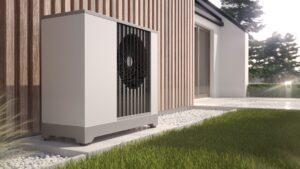Air Source Heat Pump (ASHP)
Air source heat pumps (ASHPs) have become increasingly popular in recent years as a renewable alternative to traditional heating systems.  They work by extracting heat from the air outside and using it to heat water for radiators or underfloor heating. ASHPs are known for being energy-efficient and cost-effective, but many homeowners are still unsure whether they will improve their Energy Performance Certificate (EPC) rating.
They work by extracting heat from the air outside and using it to heat water for radiators or underfloor heating. ASHPs are known for being energy-efficient and cost-effective, but many homeowners are still unsure whether they will improve their Energy Performance Certificate (EPC) rating.
An EPC is a certificate that rates the energy efficiency of a property on a scale from A to G. It takes into account factors such as insulation, heating systems, and lighting. A higher rating means a property is more energy-efficient, which can result in lower energy bills and a reduced carbon footprint. Homeowners may be interested in improving their EPC rating for a variety of reasons, such as to increase the value of their property or to comply with new regulations.
So, will an air source heat pump improve your EPC rating? The answer is not straightforward and depends on several factors, including the age and condition of your property, your current heating system, and the type of ASHP you choose. In the following article, we will explore these factors in more detail and provide you with the information you need to make an informed decision about whether an ASHP is right for your home.
Basics of Energy Performance Certificates
Energy Performance Certificates (EPCs) are documents that provide information about the energy efficiency of a building. They are required by law when a building is constructed, sold or rented. EPCs are designed to help building owners and occupiers to understand how energy efficient their property is, and to identify areas where improvements can be made.
EPCs are based on a rating system from A to G, with A being the most energy efficient and G being the least. The rating takes into account factors such as the age and construction of the building, its heating and hot water systems, and the type of insulation used.
EPCs also provide recommendations for how to improve the energy efficiency of a property. These recommendations are split into two categories: cost-effective and non-cost-effective. Cost-effective measures are those that will pay for themselves in energy savings within a reasonable timeframe, while non-cost-effective measures may take longer to pay for themselves.
It is important to note that EPCs are only a guide and do not guarantee the actual energy performance of a building. Actual energy usage will depend on a variety of factors, including how the building is used and maintained, and the behaviour of its occupants.
Overall, EPCs are a useful tool for improving the energy efficiency of a building and reducing its carbon footprint. By following the recommendations provided in an EPC, building owners and occupiers can save money on energy bills and contribute to a more sustainable future.
Understanding Air Source Heat Pumps
Functionality
Air source heat pumps (ASHPs) are a renewable energy technology that extracts heat from the air outside a building and uses it to provide heating and hot water inside. They work by absorbing heat from the outdoor air, even when the temperature is as low as -15°C, and then increasing the temperature of that heat using a compressor.
The heated air is then transferred to the building’s heating system via a heat exchanger. ASHPs can also be used for cooling in the summer by reversing the process and expelling heat from the building.
Efficiency Levels
ASHPs are known for their high efficiency levels, which means they can provide a lot of heat for a relatively small amount of energy. The efficiency of an ASHP is measured using a coefficient of performance (COP), which is the ratio of heat output to energy input. For example, a COP of 3 means that for every unit of electricity used to power the ASHP, three units of heat are produced.
The efficiency of an ASHP can vary depending on factors such as the temperature of the outdoor air, the size of the unit, and the design of the building. However, in general, ASHPs are considered to be a highly efficient form of heating.
Types
There are two main types of ASHPs: air-to-water and air-to-air. Air-to-water ASHPs are the most common type and work by transferring heat from the outdoor air to a water-based heating system, such as underfloor heating or radiators.
Air-to-air ASHPs, on the other hand, work by transferring heat from the outdoor air to a ducted air system, which is then used to provide heating and cooling to the building. While less common than air-to-water ASHPs, air-to-air ASHPs can be a good option for buildings that do not have a water-based heating system.
In conclusion, ASHPs are a renewable energy technology that can provide efficient heating and cooling to a building. By understanding how they work and the different types available, homeowners can make an informed decision about whether an ASHP is right for their home and can potentially improve their EPC rating.
Impact of Air Source Heat Pumps on EPC Ratings
Improvement Potential
Air source heat pumps (ASHPs) have the potential to significantly improve the Energy Performance Certificate (EPC) rating of a property. This is because they are a renewable energy source that can replace traditional fossil fuel heating systems, which are less efficient and produce more carbon emissions.
According to the UK government’s Simple Energy Advice website, installing an ASHP in a typical four-bedroom detached house could improve the property’s EPC rating from a D to a B, potentially saving the homeowner up to £1,300 per year on their energy bills.
However, the actual improvement in EPC rating will depend on a number of factors, including the size of the property, its insulation levels, and the type of heating system that is being replaced.
Factors Affecting EPC Improvement
The potential improvement in EPC rating from installing an ASHP will be affected by a number of factors, including:
- Property size: Larger properties will generally require more heating and therefore have a greater potential for energy savings and EPC improvement.
- Insulation levels: Properties with good insulation will be more energy-efficient and therefore have a greater potential for EPC improvement.
- Existing heating system: Properties with less efficient heating systems, such as electric storage heaters, will have a greater potential for EPC improvement than those with more efficient systems, such as gas boilers.
- Location and climate: Properties in colder climates will require more heating and therefore have a greater potential for energy savings and EPC improvement.
It is important to note that the potential improvement in EPC rating will vary depending on the specific circumstances of each property. Homeowners should consult with a qualified installer and assess the potential energy savings and EPC improvement before deciding to install an ASHP.

Installation Considerations
Professional Assessment
Before installing an air source heat pump, it is important to have a professional assessment of your property’s heating needs. This will ensure that the system is correctly sized and installed to meet your heating demands. A professional installer will also assess the suitability of your property for an air source heat pump, taking into account factors such as insulation levels, the size of your property, and your heating requirements.
Costs and Incentives
The cost of installing an air source heat pump can vary depending on the size and complexity of the system, as well as the installation location. However, it is worth noting that there are various incentives available that can help to offset the initial cost. For example, the UK government’s Renewable Heat Incentive (RHI) scheme provides financial support to homeowners who install renewable heating systems, including air source heat pumps. It is also worth considering the long-term savings that can be achieved through reduced energy bills.
Planning Permission
In most cases, planning permission is not required to install an air source heat pump. However, there are some exceptions, such as if your property is located in a conservation area or is a listed building. It is important to check with your local planning authority before installing a system to ensure that you comply with any regulations or restrictions.
Overall, installing an air source heat pump can be a cost-effective and environmentally friendly way to improve your EPC rating. However, it is important to consider the installation considerations outlined above to ensure that the system is correctly sized, installed, and compliant with any regulations or restrictions.
Long-Term Benefits
Energy Savings
One of the most significant long-term benefits of installing an air source heat pump (ASHP) is the energy savings it can provide. By replacing a traditional heating system with an ASHP, homeowners can reduce their energy bills and save money in the long run.
ASHPs work by extracting heat from the outside air and using it to heat the home. They require less energy to operate than traditional heating systems, making them more efficient and cost-effective. According to the Energy Saving Trust, an ASHP can save homeowners up to £1,400 per year on their energy bills.
Environmental Impact
In addition to the energy savings, ASHPs also have a positive impact on the environment. They produce less carbon emissions than traditional heating systems, which helps to reduce the carbon footprint of a home.
By using renewable energy sources, such as air, ASHPs can also help to reduce the reliance on fossil fuels. This makes them a more sustainable option for homeowners who want to reduce their impact on the environment.
Property Value Enhancement
Installing an ASHP can also enhance the value of a property in the long term. As more homeowners become aware of the benefits of renewable energy sources, properties with energy-efficient features such as ASHPs are becoming more desirable.
In fact, a study by the Department of Energy and Climate Change found that homes with energy-efficient features, such as ASHPs, can have a higher property value than those without. This means that installing an ASHP can not only provide long-term energy savings and environmental benefits but can also be a smart investment for homeowners looking to increase the value of their property.
Case Studies and Statistics
Air source heat pumps have been installed in many homes across the UK, and the results have been promising. According to a study by the Energy Saving Trust, homeowners who replaced their old heating system with an air source heat pump saved an average of £1,350 per year on their heating bills. This is a significant amount of money that can be put towards other household expenses.
In addition to cost savings, air source heat pumps can also improve a home’s Energy Performance Certificate (EPC) rating. A case study conducted by the Department of Energy and Climate Change found that a home with an EPC rating of D could improve to a C rating by installing an air source heat pump. This improvement is due to the increased energy efficiency of the heating system.
Another study conducted by the National Energy Foundation found that air source heat pumps can reduce a home’s carbon emissions by up to 50%. This is a significant reduction that can contribute to the UK’s overall efforts to reduce carbon emissions and combat climate change.
Overall, the statistics and case studies show that air source heat pumps can provide cost savings, improve EPC ratings, and reduce carbon emissions. Homeowners who are considering installing an air source heat pump should consult with a qualified installer to determine if it is the right choice for their home.
Government Policies and Regulations
The UK government has set ambitious targets to reduce carbon emissions and improve energy efficiency in buildings. As part of this effort, they have introduced several policies and regulations to encourage the adoption of renewable energy technologies, including air source heat pumps.
One such policy is the Renewable Heat Incentive (RHI), which provides financial incentives for homeowners and businesses to install renewable heating systems, including air source heat pumps. The RHI scheme has been in operation since 2011 and has helped to drive the uptake of renewable heating technologies across the UK.
In addition to the RHI, the UK government has also introduced regulations to improve the energy efficiency of buildings. The Energy Performance Certificate (EPC) is a mandatory requirement for all properties that are sold or rented in the UK. The EPC provides a rating of the energy efficiency of a property, with A being the most efficient and G being the least efficient.
Installing an air source heat pump can improve the EPC rating of a property, as it can help to reduce the carbon emissions and energy consumption of the heating system. This can be particularly beneficial for homeowners and landlords who are looking to improve the energy efficiency of their properties and comply with the minimum EPC rating requirements.
Overall, the UK government’s policies and regulations demonstrate a commitment to reducing carbon emissions and improving energy efficiency in buildings. The adoption of air source heat pumps can play a significant role in achieving these goals, and homeowners and businesses can benefit from financial incentives and improved EPC ratings by installing these renewable heating systems.





